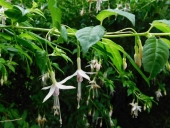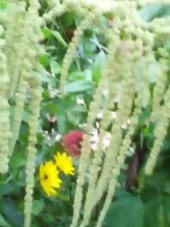posted 11 years ago
One year we planted this ornamental red amaranth neatly in a garden bed, but since then it has gone rampant as a weed. It sports showy red flower spikes, not as droopy as “love-lies-bleeding,” but similar. The local name khingama translates as “dog’s tail.”
All amaranths are edible, so we eat the leaves sometimes. You don’t need to boil it, just cook it over sautéed onions as you would spinach. It tastes good, but turns the food bright pink, so we tend to use it in tomato dishes. It has a sort of generic green vegetable flavor when cooked. Raw, it’s slightly rough but is pretty in a green salad.
When we make ketchup, we boil some in the tomato puree -- it adds a nice vegetable flavor and enriches the color. We cut off the root and seedy bits and boil whole plants in the puree, and then pull them out after a while. I tried running it through the mouli mill, but it left visible green flakes in the ketchup.
Through June, before it flowers, when weeding I pull it out, chop the whole plant up without the root, and add it to spaghetti sauce where it works perfectly. Later in the season while it’s flowering, you can still cook the leaves, but they aren’t as tender.
The weedy green amaranths are rampant and delicious too, but their flowering habit makes them sort of inedible or annoying early on, as they make fuzzy-spiky flower clusters along the stem while still small. This erect-spiked one is much easier to harvest and eat.
Red-amaranth-in-autumn.jpg
![Filename: Red-amaranth-in-autumn.jpg
Description: [Thumbnail for Red-amaranth-in-autumn.jpg]](/t/37414/a/18833/Red-amaranth-in-autumn.jpg)
Red-amaranth-in-Ladakh-as-weed-in-tomatoes.jpg
![Filename: Red-amaranth-in-Ladakh-as-weed-in-tomatoes.jpg
Description: [Thumbnail for Red-amaranth-in-Ladakh-as-weed-in-tomatoes.jpg]](/t/37414/a/18834/Red-amaranth-in-Ladakh-as-weed-in-tomatoes.jpg)
Red-amaranth-in-Ladakh.jpg
![Filename: Red-amaranth-in-Ladakh.jpg
Description: [Thumbnail for Red-amaranth-in-Ladakh.jpg]](/t/37414/a/18835/Red-amaranth-in-Ladakh.jpg)
Works at a residential alternative high school in the Himalayas SECMOL.org . "Back home" is Cape Cod, E Coast USA.









